Peng Tang
FedDEAP: Adaptive Dual-Prompt Tuning for Multi-Domain Federated Learning
Oct 21, 2025Abstract:Federated learning (FL) enables multiple clients to collaboratively train machine learning models without exposing local data, balancing performance and privacy. However, domain shift and label heterogeneity across clients often hinder the generalization of the aggregated global model. Recently, large-scale vision-language models like CLIP have shown strong zero-shot classification capabilities, raising the question of how to effectively fine-tune CLIP across domains in a federated setting. In this work, we propose an adaptive federated prompt tuning framework, FedDEAP, to enhance CLIP's generalization in multi-domain scenarios. Our method includes the following three key components: (1) To mitigate the loss of domain-specific information caused by label-supervised tuning, we disentangle semantic and domain-specific features in images by using semantic and domain transformation networks with unbiased mappings; (2) To preserve domain-specific knowledge during global prompt aggregation, we introduce a dual-prompt design with a global semantic prompt and a local domain prompt to balance shared and personalized information; (3) To maximize the inclusion of semantic and domain information from images in the generated text features, we align textual and visual representations under the two learned transformations to preserve semantic and domain consistency. Theoretical analysis and extensive experiments on four datasets demonstrate the effectiveness of our method in enhancing the generalization of CLIP for federated image recognition across multiple domains.
Neural Canonical Polyadic Factorization for Traffic Analysis
Jun 18, 2025Abstract:Modern intelligent transportation systems rely on accurate spatiotemporal traffic analysis to optimize urban mobility and infrastructure resilience. However, pervasive missing data caused by sensor failures and heterogeneous sensing gaps fundamentally hinders reliable traffic modeling. This paper proposes a Neural Canonical Polyadic Factorization (NCPF) model that synergizes low-rank tensor algebra with deep representation learning for robust traffic data imputation. The model innovatively embeds CP decomposition into neural architecture through learnable embedding projections, where sparse traffic tensors are encoded into dense latent factors across road segments, time intervals, and mobility metrics. A hierarchical feature fusion mechanism employs Hadamard products to explicitly model multilinear interactions, while stacked multilayer perceptron layers nonlinearly refine these representations to capture complex spatiotemporal couplings. Extensive evaluations on six urban traffic datasets demonstrate NCPF's superiority over six state-of-the-art baselines. By unifying CP decomposition's interpretable factor analysis with neural network's nonlinear expressive power, NCPF provides a principled yet flexible approaches for high-dimensional traffic data imputation, offering critical support for next-generation transportation digital twins and adaptive traffic control systems.
Devil's Hand: Data Poisoning Attacks to Locally Private Graph Learning Protocols
Jun 11, 2025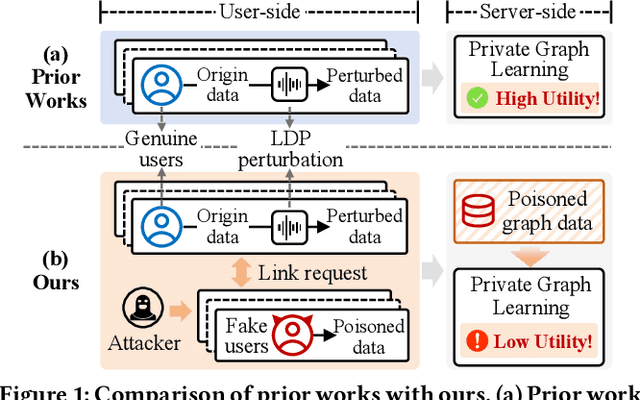
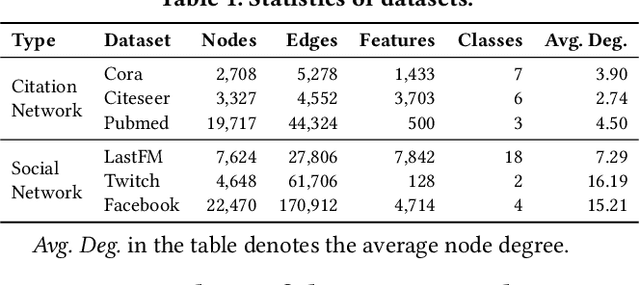
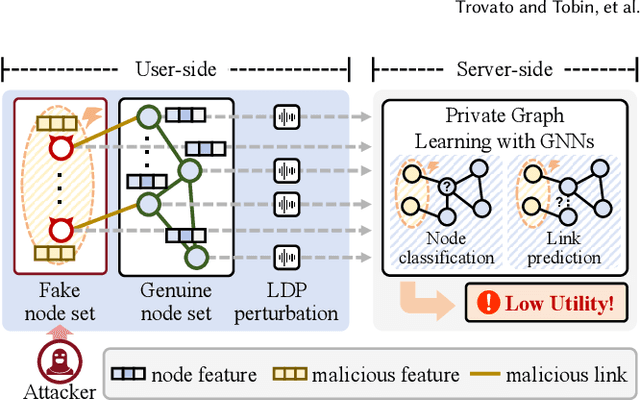
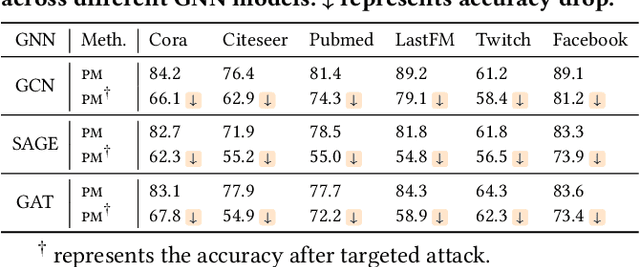
Abstract:Graph neural networks (GNNs) have achieved significant success in graph representation learning and have been applied to various domains. However, many real-world graphs contain sensitive personal information, such as user profiles in social networks, raising serious privacy concerns when graph learning is performed using GNNs. To address this issue, locally private graph learning protocols have gained considerable attention. These protocols leverage the privacy advantages of local differential privacy (LDP) and the effectiveness of GNN's message-passing in calibrating noisy data, offering strict privacy guarantees for users' local data while maintaining high utility (e.g., node classification accuracy) for graph learning. Despite these advantages, such protocols may be vulnerable to data poisoning attacks, a threat that has not been considered in previous research. Identifying and addressing these threats is crucial for ensuring the robustness and security of privacy-preserving graph learning frameworks. This work introduces the first data poisoning attack targeting locally private graph learning protocols. The attacker injects fake users into the protocol, manipulates these fake users to establish links with genuine users, and sends carefully crafted data to the server, ultimately compromising the utility of private graph learning. The effectiveness of the attack is demonstrated both theoretically and empirically. In addition, several defense strategies have also been explored, but their limited effectiveness highlights the need for more robust defenses.
Using LLMs for Automated Privacy Policy Analysis: Prompt Engineering, Fine-Tuning and Explainability
Mar 16, 2025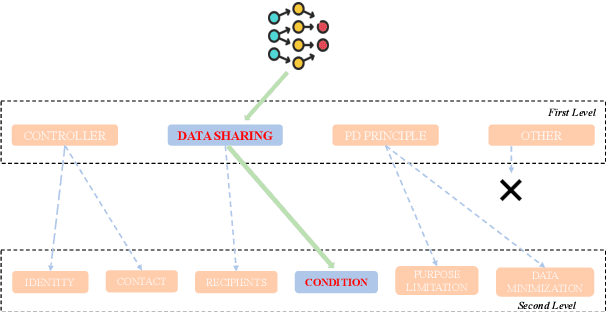
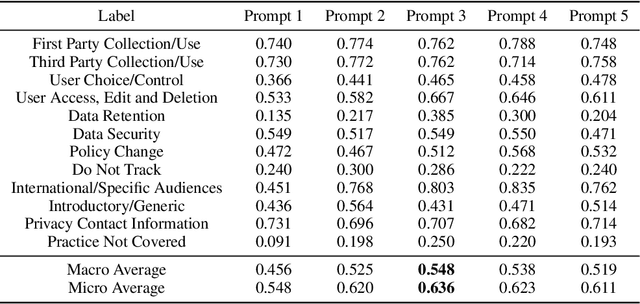
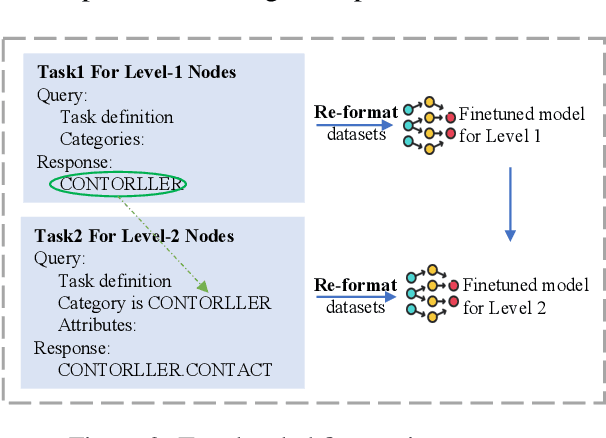
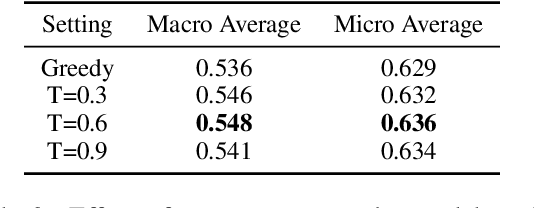
Abstract:Privacy policies are widely used by digital services and often required for legal purposes. Many machine learning based classifiers have been developed to automate detection of different concepts in a given privacy policy, which can help facilitate other automated tasks such as producing a more reader-friendly summary and detecting legal compliance issues. Despite the successful applications of large language models (LLMs) to many NLP tasks in various domains, there is very little work studying the use of LLMs for automated privacy policy analysis, therefore, if and how LLMs can help automate privacy policy analysis remains under-explored. To fill this research gap, we conducted a comprehensive evaluation of LLM-based privacy policy concept classifiers, employing both prompt engineering and LoRA (low-rank adaptation) fine-tuning, on four state-of-the-art (SOTA) privacy policy corpora and taxonomies. Our experimental results demonstrated that combining prompt engineering and fine-tuning can make LLM-based classifiers outperform other SOTA methods, \emph{significantly} and \emph{consistently} across privacy policy corpora/taxonomies and concepts. Furthermore, we evaluated the explainability of the LLM-based classifiers using three metrics: completeness, logicality, and comprehensibility. For all three metrics, a score exceeding 91.1\% was observed in our evaluation, indicating that LLMs are not only useful to improve the classification performance, but also to enhance the explainability of detection results.
Multi-Head Self-Attending Neural Tucker Factorization
Jan 16, 2025

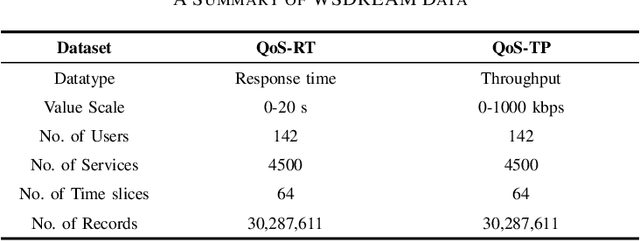

Abstract:Quality-of-service (QoS) data exhibit dynamic temporal patterns that are crucial for accurately predicting missing values. These patterns arise from the evolving interactions between users and services, making it essential to capture the temporal dynamics inherent in such data for improved prediction performance. As the size and complexity of QoS datasets increase, existing models struggle to provide accurate predictions, highlighting the need for more flexible and dynamic methods to better capture the underlying patterns in large-scale QoS data. To address this issue, we introduce a neural network-based tensor factorization approach tailored for learning spatiotemporal representations of high-dimensional and incomplete (HDI) tensors, namely the Multi-head Self-attending Neural Tucker Factorization (MSNTucF). The model is elaborately designed for modeling intricate nonlinear spatiotemporal feature interaction patterns hidden in real world data with a two-fold idea. It first employs a neural network structure to generalize the traditional framework of Tucker factorization and then proposes to leverage a multi-head self-attending module to enforce nonlinear latent interaction learning. In empirical studies on two dynamic QoS datasets from real applications, the proposed MSNTucF model demonstrates superior performance compared to state-of-the-art benchmark models in estimating missing observations. This highlights its ability to learn non-linear spatiotemporal representations of HDI tensors.
A Survey on Inference Optimization Techniques for Mixture of Experts Models
Dec 18, 2024



Abstract:The emergence of large-scale Mixture of Experts (MoE) models has marked a significant advancement in artificial intelligence, offering enhanced model capacity and computational efficiency through conditional computation. However, the deployment and inference of these models present substantial challenges in terms of computational resources, latency, and energy efficiency. This comprehensive survey systematically analyzes the current landscape of inference optimization techniques for MoE models across the entire system stack. We first establish a taxonomical framework that categorizes optimization approaches into model-level, system-level, and hardware-level optimizations. At the model level, we examine architectural innovations including efficient expert design, attention mechanisms, various compression techniques such as pruning, quantization, and knowledge distillation, as well as algorithm improvement including dynamic routing strategies and expert merging methods. At the system level, we investigate distributed computing approaches, load balancing mechanisms, and efficient scheduling algorithms that enable scalable deployment. Furthermore, we delve into hardware-specific optimizations and co-design strategies that maximize throughput and energy efficiency. This survey not only provides a structured overview of existing solutions but also identifies key challenges and promising research directions in MoE inference optimization. Our comprehensive analysis serves as a valuable resource for researchers and practitioners working on large-scale deployment of MoE models in resource-constrained environments. To facilitate ongoing updates and the sharing of cutting-edge advances in MoE inference optimization research, we have established a repository accessible at \url{https://github.com/MoE-Inf/awesome-moe-inference/}.
HOBBIT: A Mixed Precision Expert Offloading System for Fast MoE Inference
Nov 03, 2024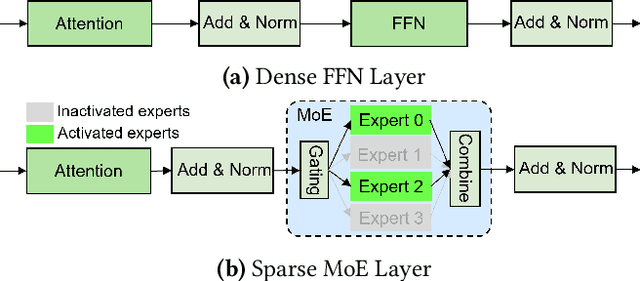
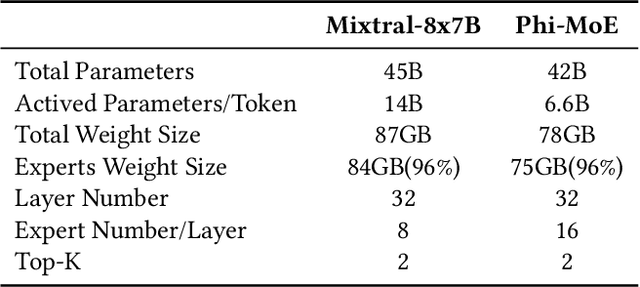
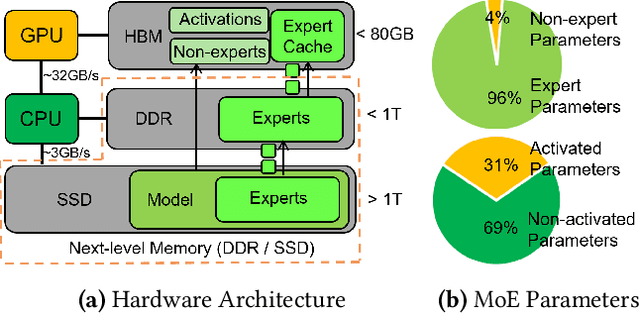

Abstract:The Mixture-of-Experts (MoE) architecture has demonstrated significant advantages in the era of Large Language Models (LLMs), offering enhanced capabilities with reduced inference costs. However, deploying MoE-based LLMs on memoryconstrained edge devices remains challenging due to their substantial memory requirements. While existing expertoffloading methods alleviate the memory requirements, they often incur significant expert-loading costs or compromise model accuracy. We present HOBBIT, a mixed precision expert offloading system to enable flexible and efficient MoE inference. Our key insight is that dynamically replacing less critical cache-miss experts with low precision versions can substantially reduce expert-loading latency while preserving model accuracy. HOBBIT introduces three innovative techniques that map the natural hierarchy of MoE computation: (1) a token-level dynamic expert loading mechanism, (2) a layer-level adaptive expert prefetching technique, and (3) a sequence-level multidimensional expert caching policy. These innovations fully leverage the benefits of mixedprecision expert inference. By implementing HOBBIT on top of the renowned LLM inference framework Llama.cpp, we evaluate its performance across different edge devices with representative MoE models. The results demonstrate that HOBBIT achieves up to a 9.93x speedup in decoding compared to state-of-the-art MoE offloading systems.
DocKD: Knowledge Distillation from LLMs for Open-World Document Understanding Models
Oct 04, 2024



Abstract:Visual document understanding (VDU) is a challenging task that involves understanding documents across various modalities (text and image) and layouts (forms, tables, etc.). This study aims to enhance generalizability of small VDU models by distilling knowledge from LLMs. We identify that directly prompting LLMs often fails to generate informative and useful data. In response, we present a new framework (called DocKD) that enriches the data generation process by integrating external document knowledge. Specifically, we provide an LLM with various document elements like key-value pairs, layouts, and descriptions, to elicit open-ended answers. Our experiments show that DocKD produces high-quality document annotations and surpasses the direct knowledge distillation approach that does not leverage external document knowledge. Moreover, student VDU models trained with solely DocKD-generated data are not only comparable to those trained with human-annotated data on in-domain tasks but also significantly excel them on out-of-domain tasks.
An Adaptive Latent Factorization of Tensors Model for Embedding Dynamic Communication Network
Aug 29, 2024



Abstract:The Dynamic Communication Network (DCN) describes the interactions over time among various communication nodes, and it is widely used in Big-data applications as a data source. As the number of communication nodes increases and temporal slots accumulate, each node interacts in with only a few nodes in a given temporal slot, the DCN can be represented by an High-Dimensional Sparse (HDS) tensor. In order to extract rich behavioral patterns from an HDS tensor in DCN, this paper proposes an Adaptive Temporal-dependent Tensor low-rank representation (ATT) model. It adopts a three-fold approach: a) designing a temporal-dependent method to reconstruct temporal feature matrix, thereby precisely represent the data by capturing the temporal patterns; b) achieving hyper-parameters adaptation of the model via the Differential Evolutionary Algorithms (DEA) to avoid tedious hyper-parameters tuning; c) employing nonnegative learning schemes for the model parameters to effectively handle an the nonnegativity inherent in HDS data. The experimental results on four real-world DCNs demonstrate that the proposed ATT model significantly outperforms several state-of-the-art models in both prediction errors and convergence rounds.
MDS-GNN: A Mutual Dual-Stream Graph Neural Network on Graphs with Incomplete Features and Structure
Aug 09, 2024Abstract:Graph Neural Networks (GNNs) have emerged as powerful tools for analyzing and learning representations from graph-structured data. A crucial prerequisite for the outstanding performance of GNNs is the availability of complete graph information, i.e., node features and graph structure, which is frequently unmet in real-world scenarios since graphs are often incomplete due to various uncontrollable factors. Existing approaches only focus on dealing with either incomplete features or incomplete structure, which leads to performance loss inevitably. To address this issue, this study proposes a mutual dual-stream graph neural network (MDS-GNN), which implements a mutual benefit learning between features and structure. Its main ideas are as follows: a) reconstructing the missing node features based on the initial incomplete graph structure; b) generating an augmented global graph based on the reconstructed node features, and propagating the incomplete node features on this global graph; and c) utilizing contrastive learning to make the dual-stream process mutually benefit from each other. Extensive experiments on six real-world datasets demonstrate the effectiveness of our proposed MDS-GNN on incomplete graphs.
 Add to Chrome
Add to Chrome Add to Firefox
Add to Firefox Add to Edge
Add to Edge